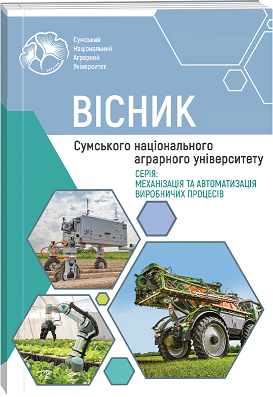МЕТОДИЧНІ ТА ЕКОНОМІЧНІ ПІДХОДИ ВІДНОСНО ВИЗНАЧЕННЯ ВИТРАТ ПАЛИВА ТРАНСПОРТНИХ ЗАСОБІВ ПРИ ПЕРЕВЕЗЕННІ ЗЕРНА ВІД ЗЕРНОЗБИРАЛЬНИХ КОМБАЙНІВ
Ключові слова:
автомобіль, комбайн, збирання, швидкість руху, продуктивність, витрати палива
Анотація
В запропонованій статті наведені методичні та економічні підходи стосовно визначення основних техніко-експлуатаційних показників вантажних автомобілів при транспортуванні зерна від комбайна при збиранні озимої пшениці, що дає можливість визначити в подальшому безпосередньо ефективність їх використання в виробничих умовах.
Посилання
1. Mikulina M., Polyvanyi A. INTERNATIONAL ASPECTS OF CONTROLLING OF TRANSPORT AND LOGISTICS COMPLEXES // The 2 nd International scientific and practical conference “Modern directions of scientific research development” (August 4-6, 2021) BoScience Publisher, Chicago, USA. 2021. 448 p. С. 59-64
2. Поливаний А.Д., Мікуліна М.О. Логістична концепція транспортних підприємств// Матеріали Всеукраїнської студент-ської науковій конференції (11- 15 листопада 2019 р.).– Суми, 2019. С.270
3. Мікуліна М. О. Барабаш Г.І., Поливаний А.Д. Вплив схем розвантаження комбайна на показники використання тран-спортного засобу [Електронний ресурс]. The 5th International scientific and practical conference «Science and education: problems, prospects and innovations», (February 4-6, 2021). – Kyoto : CPN Publishing Group, 2021. – Р. 691-699.
4. Мікуліна М.О. Оцінка тракторів з різним типом рушіїв [Електронний ресурс]. Збірник тез доповідей по матеріалах XXI Міжнародної наукової конференції „Сучасні проблеми землеробської механіки”. Харків: ХНТУСГ, 2020. 370 с.. С.130 – 131.
2. Поливаний А.Д., Мікуліна М.О. Логістична концепція транспортних підприємств// Матеріали Всеукраїнської студент-ської науковій конференції (11- 15 листопада 2019 р.).– Суми, 2019. С.270
3. Мікуліна М. О. Барабаш Г.І., Поливаний А.Д. Вплив схем розвантаження комбайна на показники використання тран-спортного засобу [Електронний ресурс]. The 5th International scientific and practical conference «Science and education: problems, prospects and innovations», (February 4-6, 2021). – Kyoto : CPN Publishing Group, 2021. – Р. 691-699.
4. Мікуліна М.О. Оцінка тракторів з різним типом рушіїв [Електронний ресурс]. Збірник тез доповідей по матеріалах XXI Міжнародної наукової конференції „Сучасні проблеми землеробської механіки”. Харків: ХНТУСГ, 2020. 370 с.. С.130 – 131.
Опубліковано
2022-05-05
Як цитувати
Барабаш, Г. І., Мікуліна, М. О., & Поливаний, А. Д. (2022). МЕТОДИЧНІ ТА ЕКОНОМІЧНІ ПІДХОДИ ВІДНОСНО ВИЗНАЧЕННЯ ВИТРАТ ПАЛИВА ТРАНСПОРТНИХ ЗАСОБІВ ПРИ ПЕРЕВЕЗЕННІ ЗЕРНА ВІД ЗЕРНОЗБИРАЛЬНИХ КОМБАЙНІВ. Вісник Сумського національного аграрного університету. Серія: Механізація та автоматизація виробничих процесів, (2 (44), 13-16. https://doi.org/10.32845/msnau.2021.2.3

 ISSN
ISSN  ISSN
ISSN 



